Managing the Pain: Inez C. Hardin
I retired on 30 September 1998 from a job where I had worked for 18 years, after that time I babysat my two grandchildren for two years while their mother worked. I sometimes babysat the children three or four times a week. Recently, they went on vacation and I now have lots of time on my hands. So I decided that I would get as much information as I possibly can about sickle cell disease, which I have suffered from all of my life, I will be 69 years old on 26 July 2000.
Ola’s Story
Fortunately or unfortunately – or both, I am one of the over one million Nigerians afflicted with sickle cell disease. I have written a story which details my on-going grappling with the disease, the attempts to get cured or alleviate suffering through various orthodox and unorthodox means including urine and water fasts. It also tells of my growing up in a polygamous family ruled by an authoritarian father; of smoking and alcohol abuse in early life; of being sexually molested at the age of seven of difficulties at home and school and work caused by health impairment; and of my singular experiences which resulted in my repudiation of religious orthodoxy. At another level, it is the story of other sicklers and ‘normals’ in my extended family.
Good Medical Care and Strong Family Support Can Go a Long Way: Letter from Debbie Thomas
The one overall theme I am reading from this site is the importance of good medical care and strong family support.
I am a 37 year old woman with SC disease. My story is very similar to those posted here. It breaks my heart to see people with Sickle Cell living their life as if they don’t have a life. I try to educate the parents I come in contact with but are often looked at as if I don’t know what I am talking about.
The Psychological Impact of Sickle Cell: Fola Ogunnowo
I was born in Nigeria but reside in England. I discovered I have sickle cell disease at the age of 13.Before; I was always in and out of the hospital. No one in my family thought of this disease since I’m only the person in my whole family. Before coming to England, I’ve suffered unthinkable and unbearable pains in my life, pains no one can ever understands except the person suffering from it.
Monica’s Struggle with Pain Medication
I’m 23yrs. old with SC. I was diagnosed with Sickle Cell disease at 18 months. I have always been very stubborn with taking care of myself as far as drinking plenty of fluids and taking folic acid on an everyday basis.
My mother always pushes me too drink water even now as an adult woman living in my own house. I consider myself as being a very weak individual. My crises have gotten less frequent over the past 2 years. Sadly but not ashamed to say I have become very addicted to my pain medication, it first started when I became pregnant Nov. 2001.
Sheila Holds on to Hope
Greetings from California,
My name is Sheila Marchbanks, I’m a 46 years old and I am living a very full though sometimes challenged life. I was diagnosed with Sickle Cell Disease as a child. The initial diagnosis was that I carried the trait, later I was incorrectly diagnosed with Sickle Cell Anemia, and as an young adult correctly diagnosed with Sickle Cell Beta Thalassemia. Throughout my life I have lived with denial (by myself as well as family members), with pain, with confusion, with erroneous medical information, and with hope.
Kennedy’s Story
When we first went to the hematologist (St. Vincent Hospital) my husband and I were never given a straight answer on whether our daughter had the disease or had the trait. This is when we took our daughter to Riley Hospital for Children to find out what was really wrong with her.
Photos from It’s in the Blood! A Documentary History of Linus Pauling, Hemoglobin, and Sickle Cell Anemia
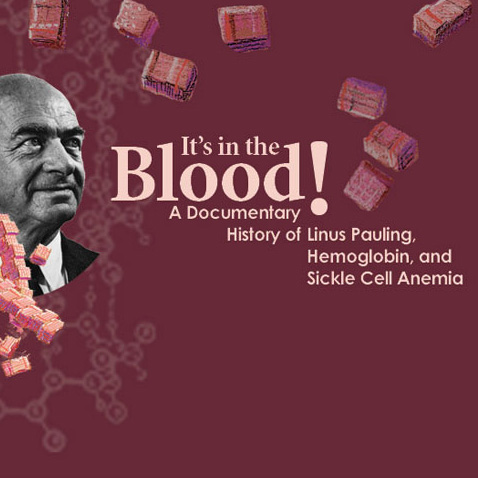
These images were pulled from the It’s in the Blood! A Documentary History of Linus Pauling, Hemoglobin, and Sickle Cell Anemia which was originally put together by the Special Collections & Archives Research Center at Oregon State University. The documentary provides a closer look at Pauling’s work in blood biochemistry and molecular disease primarily through narratives, timelines, media, and primary documents. Click on the image to left to view some of the pictures from the collection.
Sickle Cell Newsletter for February 2016
Antiplatelet Drug Doesn’t Reduce Pain of Sickle Cell Anemia Children and adolescents with sickle cell anemia who received the adenosine diphosphate–directed antiplatelet agent prasugrel had no significant reduction in painful vasoocclusive crises compared with those who received placebo, found a trial conducted in 13 countries (Heeney MM et al. N Engl J Med. doi:10.1056/NEJMoa1512021 [published […]
Sickle Cell Newsletter for January 2016
UAB Adult Sickle Cell Clinic receives $1 million from Sickle Cell Foundation There has been a dramatic change in sickle cell disease treatment outcomes in our lifetimes. In the early 1970s, being diagnosed with this genetic disorder was more like receiving a death sentence. Children were not expected to live past the age of 16. […]
Sickle Cell Newsletter for December 2015
Gene Therapy is on the Way “Bubble baby” stem cell treatment looks like a cure and paves way for Sickle Cell Disease Treatment The first therapeutics based on genome-editing tools will treat diseases caused by single genes, but many other factors dictate what is currently possible. Data Back Transplant as Cure for Sickle Cell More […]
Sickle Cell Newsletter for November 2015
Sickle cell disease cure in sights of UAB Stem Cell Institute See more at: http://alabamanewscenter.com/2015/11/13/sickle-cell-disease-cure-in-sights-of-uab-stem-cell-institute/#sthash.UcB4ug9H.dpuf Chevron Boosts Its Support Of The Angola Sickle Cell Initiative https://www.polymerupdate.com/press-releases/press-release-details.aspx?id=10275 Chevron Corp. is continuing its support of the Angola Sickle Cell Initiative by committing an additional $5 million endowment over the course of five years. The oil and gas […]
Lorem Ipsum
Lorem ipsum dolor sit amet, consectetur adipiscing elit. Suspendisse id vehicula risus, vitae rutrum sapien. Suspendisse finibus rhoncus dapibus. Quisque tincidunt nibh ut elit viverra, non fermentum magna pretium. Morbi felis lacus, fermentum et lacinia in, pretium vitae magna. Aenean convallis at quam aliquet gravida. Lorem ipsum dolor sit amet, consectetur adipiscing elit. Sed laoreet […]
Sickle Cell Disease – A Lethal Advantage: Video Series from the Open University

The History of the Sickle-Shaped Cell – Sickle Cell Disease: A Lethal Advantage (1/5) This is the first part of a video series from Open University. This video tracks the history of sickle cell beginning with the very first diagnosis. Sickle Cell and the Gene – Sickle Cell Disease: A Lethal Advantage (2/5) The second part […]
Photograph of Dr. Clarice D. Reid
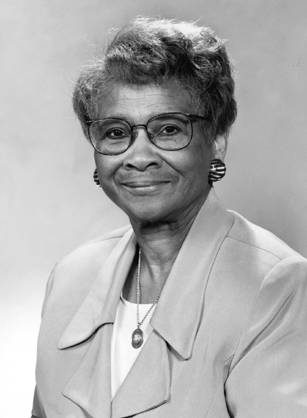
This is a photograph of Dr. Clarice D. Reid who was the pediatrician who led the National Sickle Cell Disease Program at the U.S. National Heart, Lung, and Blood Institute with the National Institute of Health.
U.S. Postage Stamp (2004)
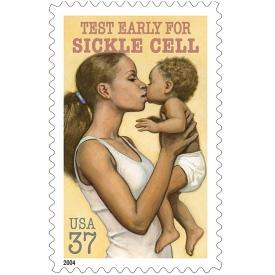
In 2004, the U.S. Postal Service created this stamp as part of a program to raise public awareness on sickle cell disease.
Photograph of Dr. Marilyn Gaston
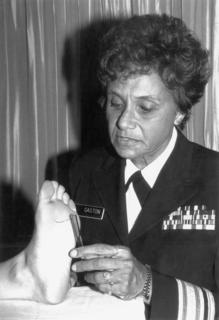
This is a photo of Dr. Marilyn Gaston who is internationally recognized for her work on sickle cell and helping children manage the illness.
Richard Severo, New York Times Article Series on Genetic Screening & Sickle Cell Disease (1981-1982)

AIR ACADEMY TO DROP ITS BAN ON APPLICANTS WITH SICKLE CELL GENE: February 4, 1981 This New York Times article is the first of a series to cover the removal of a ban that excluded Air Force Academy applicants with a single gene for sickle cell anemia. DUPOINT DEFENDS GENETIC SCREENING: OCTOBER 18, 1981 […]
Forward to Living in the Genetic Age: New Issues, New Challenges (2009)
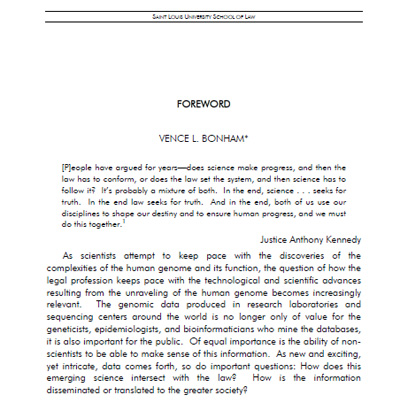
By Vence L. Bonham
Saint Louis University Journal of Health Law & Policy, Volume 3, Issue 1, 2009
Sickle Cell Anemia: A Report of Eight Cases, One With Necropsy (1934)
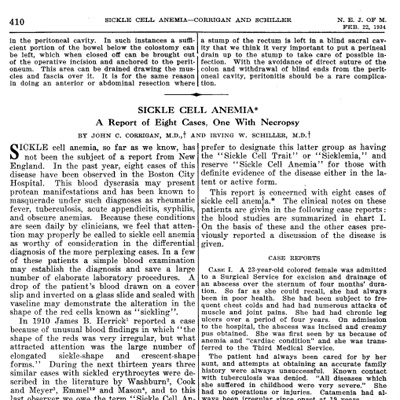
By John C. Corrigan, M.D., and Irving W. Schiller, M.D.
New England Journal of Medicine, Volume 210, Number 8, pages 410-417
Sickle-Cell Disease (1997)
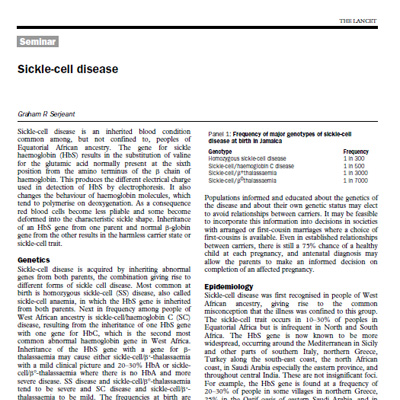
By Graham R. Serjeant
Lancet, Volume 350, pages 725-730
The Inheritance of Sickle Cell Anemia (1949)
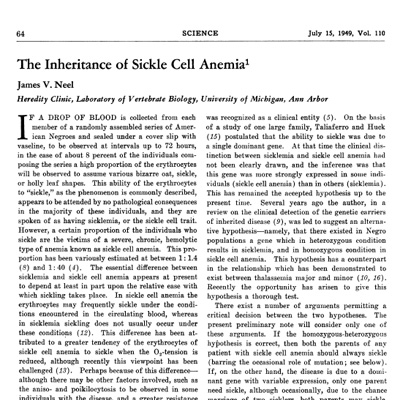
By James V. Neel
Science, Volume 110, pages 64-66
Johns Hopkins University: Vision of Hope-Integration of Palliative Care in Chronic Pediatric Disease
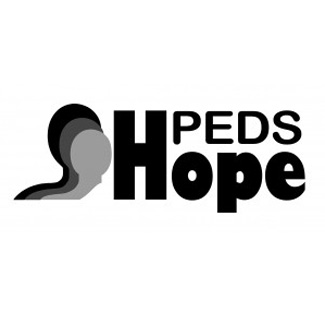
The Vision of Hope curriculum was motivated by a commitment to integrate the principles of pediatric palliative care to sickle cell disease and duchenne muscular dystrophy. Pediatric Palliative Care seeks to provide evidence-based curricular materials to institutions. It incorporates emotional, spiritual, developmental, and physical dimensions creating a holistic approach to care. The Johns Hopkins Berman Institute has created 11 modules to help guide healthcare providers on this approach. Scroll down on the linked page and click the sickle cell link to view the different resources.
Click here to visit the site: http://www.bioethicsinstitute.org/research/projects-2/hope
Basketball

In this video, watch the inspirational story of Billy Garret Jr. who is balancing life as college-level basketball athlete at DePaul University and life as a sickle cell patient. Billy Garrett Jr. was awarded the 2014 Big East Rookie of the Year and is a two-time Big East All-Academic Team member. Billy Garrett Jr. encourages other sickle cell patients to feel empowered to do what anything they want.
Sickle Cell Disease Animation Video from A São José do Rio Preto’s Science and Technology Academy
This video was created by the São José do Rio Preto’s Science and Technology Academy in Brazil. It takes a closer look at what happens inside the red blood cells in sickle cell patients.
FDA Be Safe Online Prescription Campaign

Before you consider purchasing prescription medicines from an online pharmacy, especially one that’s not associated with a health insurance plan or local “brick and mortar” pharmacy, check out FDA’s BeSafeRx – Know Your Online Pharmacy website and resources.
A Century of Progress: Milestones in Sickle Cell Disease Research and Care

Download a PDF timeline from the National Heart Lung and Blood Institute on the history of advancements in sickle cell disease treatment and research.
MedlinePlus en Español

La anemia falciforme es una enfermedad en la que su cuerpo produce glóbulos rojos con forma anormal. Las células tienen forma semilunar o de una hoz. Estas células no duran tanto como las normales, los glóbulos rojos redondos. Esto causa la aparición de anemia. Las células falciformes también se atascan en los vasos sanguíneos y bloquean el flujo. Eso puede provocar dolor y lesionar los órganos.
Sickle Cell Anemia Life by Ed Jenkins
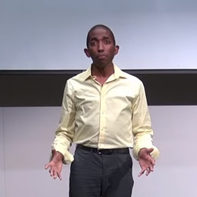
Ed Jenkins shares his story living with sickle cell anemia at the University of Minnesota Medical School. He discusses how he responds to sickle cell crisis, and what he has learned from his experiences.
The Impact of Sickle Cell Disease by Mast Therapeutics

Sickle cell disease patients and caregivers discuss how sickle cell impacts various parts of their life and how share their hopes and dreams for the future.


